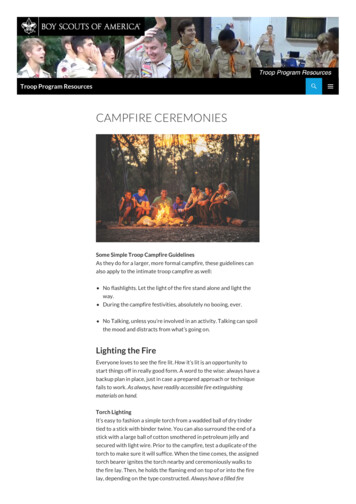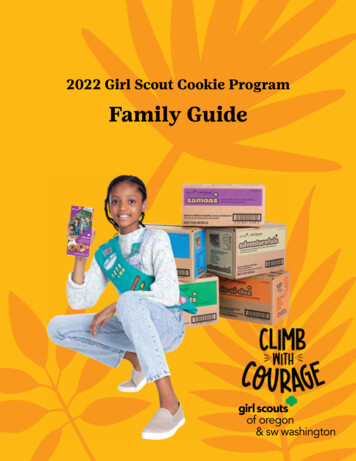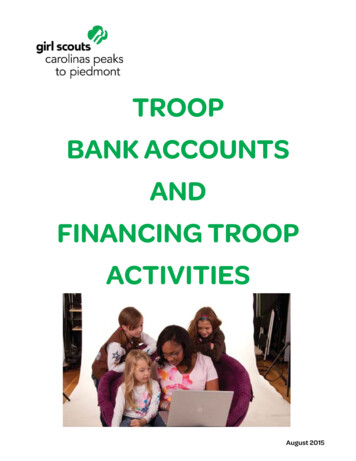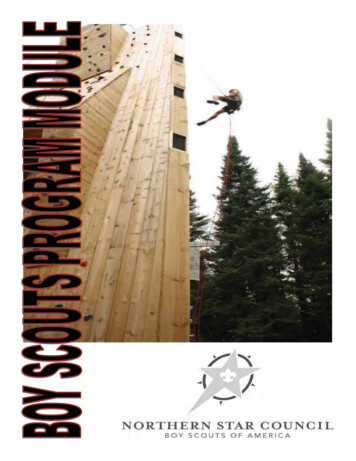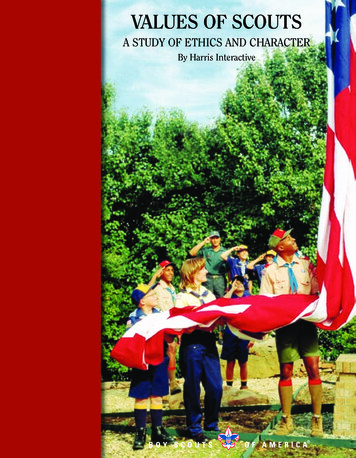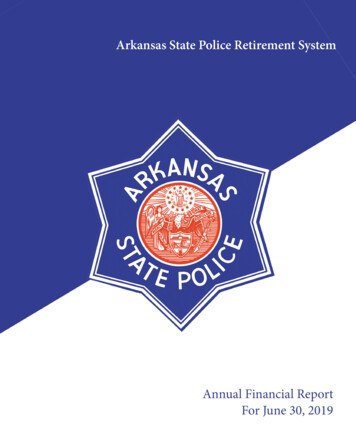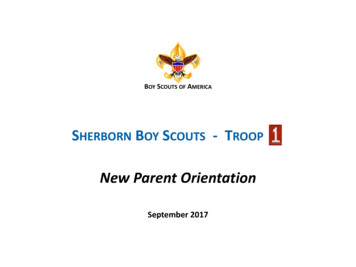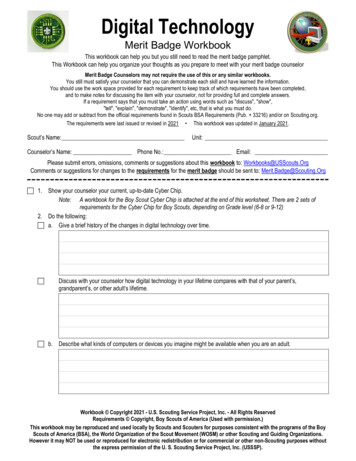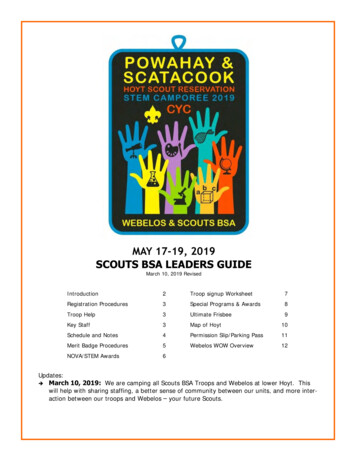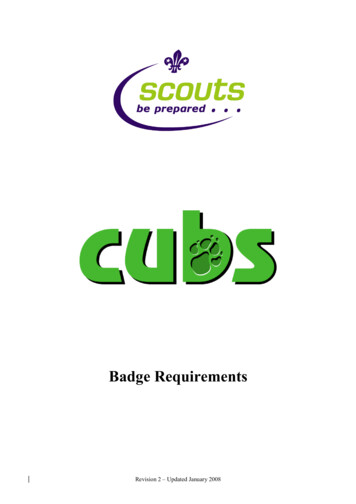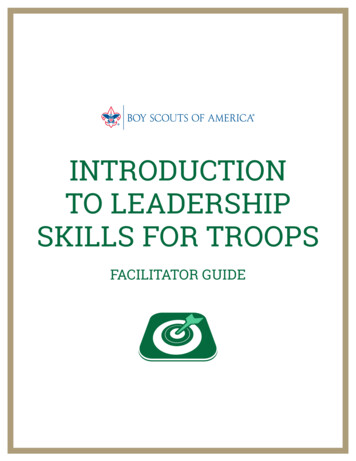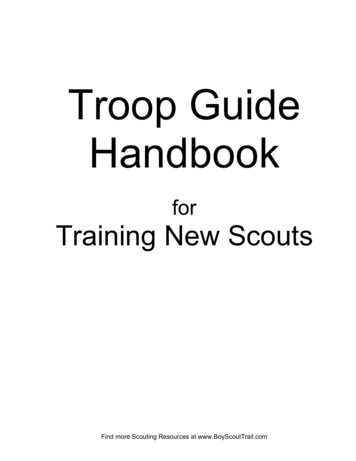
Transcription
Troop GuideHandbookforTraining New ScoutsFind more Scouting Resources at www.BoyScoutTrail.com
First Class AdvancementPage 2ContentsINTRODUCTION3SKILLS INSTRUCTION TEACHING PLANS5CAMPING ICAMPING IICITIZENSHIPCOOKINGEMERGENCIESFIRES AND FIRE SAFETYFIRST AID BASICS IFIRST AID BASICS IIFIRST AID BANDAGESFIRST AID CPRFIRST AID HURRY CASESFIRST AID RESCUESFITNESS IFORMING THE PATROLKNOTS AND LASHINGS IKNOTS AND LASHINGS IIOUTDOOR ETHICSMAP AND COMPASS IMAP AND COMPASS IIMAP AND COMPASS IIINATURE INATURE IIWATER SAFETYTOTIN’ 27282931FLAG QUIZFIRST AID SITUATION CARDSPRESENTATION SCHEDULE WORKSHEETPROGRAM PLANNING WORKSHEETPROGRAM PLAN BY MONTHEXERCISE CHARTFind more Scouting Resources at www.BoyScoutTrail.com353637383940
First Class AdvancementPage 3IntroductionAs a Troop Guide, your main goal is to make the first year of scouting a successful, fun, growingexperience for the newest scouts in our troop. Giving them an excellent adventure right off the startwill help ensure the health of our troop and advancement of the individual scouts.These skill teaching sessions are intended to help you guide the scouts in your charge. Our aim isto support new scouts in reaching First Class, as much as we can by providing training and fun tohelp them advance.You are expected to use the EDGE method for all your teaching. There should be a lot more DOingthan LISTENing by the scouts. Most sessions should take less than 25 minutes to complete so theyare perfect for a troop meeting, patrol meeting, or campout. But, they will require quite a bit ofpreparation on your part and keeping the scouts focused on the goal.Some sessions mention the need for materials, such as muffin mix in “Camping I”. You also maywant to purchase items such as small prizes for contests to make the sessions more fun. Pleasecheck with the Scoutmaster to see what your budget is and save your receipts so you can bereimbursed for things you need to buy to train the scouts. We do not want you or your family to haveany additional expenses because of your work in this position.The table below lists the plans in the program according to what rank they apply. To make it easierfor scouts to advance, concentrate on the plans for Scout, then Tenderfoot, then Second Class, andfinally First Class. But, use them in the order you feel is most appropriate as they fit into your troopoutings and monthly themes.Scout (Joining)Forming the PatrolKnots and Lashings ITotin’ ChipTenderfootCamping ICamping IIOutdoor EthicsCookingKnots and Lashings ITotin’ ChipFirst Aid Basics IForming the PatrolFitness IFitness IISecond ClassOutdoor EthicsCamping IIFires and Fire SafetyTotin’ ChipCookingKnots and Lashings IIMap and Compass IMap and Compass IIINature IWater SafetyFirst Aid Basics IIFirst Aid Hurry CasesEmergenciesCitizenshipFirst ClassOutdoor EthicsCookingKnots and Lashings IIMap and Compass IINature IIEmergenciesWater SafetyFirst Aid BandagesFirst Aid RescuesFirst Aid CPRCitizenshipYou will need to attend PLC meetings to ensure your plans for teaching the scouts are included inthe troop’s plans.You will be more successful if you enlist the help of a buddy or two for some of the sessions.Find more Scouting Resources at www.BoyScoutTrail.com
First Class AdvancementPage 4Sample First Year ProgramThis is a sample way to order the sessions to offer them all in a year.A scout participating in all troop and patrol activities can advance quickly.LocationApril OutingMay OutingJune OutingRequirementGoalsPresentation/DescriptionJ1, J2, J3, T5aT1a, T5b-cJ5, T3d, S2bS2a,c,dT6a-bJ4a-b, T3a-c, T8T1b, S1cT2a-c, S2e, F2a-eT1c, S1b, F1b, F9cT4a-dS3a—c, F4bS3dS4, F5aForming the PatrolCamping ITotin’ ChipFires and Fire SafetyFitness IKnots and Lashings ICamping IICookingOutdoor EthicsFirst Aid Basics IMap and Compass IMap and Compass IIINature I & IICourt of Honor – Scout doneWater SafetyFitness IISwimming and boating requirementsS5a-d, F6a-eT6cJuly SummerCampS6a,S6cAugust Outing S4, F5aS6d-e, F5b-d, F7d-fS6bSept OutingF4aS2f-g, F3a-dFirst Aid Basics IIEmergenciesFirst Aid Hurry CasesCourt of Honor – Tenderfoot doneMap and Compass IIKnots and Lashings IIOct OutingS8a-b, S9a-b, F9a-b, CitizenshipF10F7aFirst Aid BandagesNov OutingF7bF7cFirst Aid RescuesFirst Aid CPRDec OutingCourt of Honor – Second Class doneJan OutingFeb OutingMar OutingCourt of Honor – First Class doneFind more Scouting Resources at www.BoyScoutTrail.com
First Class AdvancementPage 5Skills Instruction Teaching PlansThe table below lists requirements in order and the session where the information is presented.This could help you find which session to use for a couple scouts needing a certain requirement.M do at a Meeting, C do at a Campout, O do at 6a6b6c7a8Second Class1a1b1c2a2b2c2d2e2f2g3a3b3c3dOForming the PatrolForming the PatrolForming the PatrolKnots and Lashings ITotin ChipCamping ICamping IIOutdoor EthicsCookingKnots and Lashings IKnots and Lashings IKnots and Lashings ITotin ChipFirst Aid Basics IForming the PatrolCamping ICamping IFitness IFitness IFitness IICitizenshipKnots and Lashings IOutdoor EthicsCamping IIFires and Fire SafetyTotin ChipFires and Fire SafetyFires and Fire SafetyCookingKnots and Lashings IIKnots and Lashings IIMap and Compass IMap and Compass IMap and Compass IMap and Compass III456a6b6c6d6e78a8b8c8d9a9bFirst Class1a1b234a4b5a5b5c5d67a7b7c7d7e89a9b9c10Nature IWater SafetyFirst Aid Basics IIFirst Aid Hurry CasesFirst Aid Basics zenshipCitizenshipOutdoor EthicsCookingKnots and Lashings IIMap and Compass IIMap and Compass INature IIEmergenciesEmergenciesEmergenciesWater SafetyFirst Aid BandagesFirst Aid RescuesFirst Aid door EthicsCitizenshipFind more Scouting Resources at www.BoyScoutTrail.com
First Class ProgramPage 6Camping ILearning ObjectivesEach scout should be able to: (pages 237-255, 257-287) Complete requirements T1a, T5b, T5c Know what to bring and what not to bring on a campout, and how to pack Know what equipment is necessary for sleeping comfortably in the outdoors Know what to do if lost Know safe hiking rulesMaterials Required Paper and pencil for each scoutSleeping bag and padPack and plastic pack cover Overnight clothes for the seasonUsual equipment for an overnightDiscoveryBefore the presentation, arrange the overnight gear on a table or the floor. Allow scouts to examinethe gear. Ask scouts how many times they have been camping before and what type of camping itwas.Teaching-LearningI.Explain: Help scouts understand why having the correct equipment is important for safety,comfort, and fun. What happens if it rains and you don’t have a raincoat? What happens if youhave to use the bathroom at night and don’t have a flashlight? Ask other leading questions.Tell Scouts that proper clothing is important. Ask them what they might bring.II. Demonstrate:A. Ask scouts to name and tell the purpose of equipment items you brought.B. Show scouts the clothing that you have brought and explain its advantages.C. Show scouts how to pack the pack properly, distributing heavy items correctly.III. Guide:A. Have each scout write down every item they remember that was packed into the pack, inone minute. Then, dump everything out and see who remembered the most.B. Have scouts repack the pack properly, discussing it together.IV. Demonstrate putting the pack cover on the pack. Ask them when the cover would be used –while hiking in rain, but more importantly at night. Tell them that by keeping their pack outsidethe tent and covered, they will be much more comfortable sleeping at night.V. Enable: Show scouts where in their handbooks they can find clothing and equipment to bringwith them on this month’s outing. Tell them that if they come prepared and early, they will beable to complete requirement T1a.VI. Discussion of Hiking Rules: Cover each of the following by asking questions:A. LNT – cut switchbacks, stay on trail, hike single file, space between scouts, bikers horsesand petsB. Off-trail hiking – don’t do it until older. Use durable surfaces like snow, rock, sand, dirt.C. Road hiking – only when necessary, light-colored clothes, single file, left side, flashlightD. If lost – STOP – Stay calm, Think, Observe, PlanFind more Scouting Resources at www.BoyScoutTrail.com
First Class ProgramPage 7Camping IILearning ObjectivesEach scout should be able to: (pages 264-266, 274-281) Complete requirements T1b, S1c Understand the importance of a sleeping pad and proper sleeping bag Know how and where to set up a campsite and tentMaterials Required 2 tents with poles, stakes, ground cloth2 hammers Sleeping bagSleeping padDiscoverySince setting up a tent takes awhile, have their tents in bags ready to go.Teaching-LearningI.Explain: Move outside. Choose a location for a campsite and explain why you chose that spot:A. Level, but with good drainage.E. Water and FirewoodB. Free of lumps, stumps, etc.F. Privacy and PermissionC. Safe from dead limbsG. Low environmental impact –leafs and duff ratherD. Sizethan green grass. Use established campsites.II. Demonstrate: Lay ground cloth and pitch the tent. Ask scouts if they have ever stayed out in atent before. Ask the scouts if they have ever set a tent like this up before. Put the sleeping padand bag in the tent. Review that leaving packs covered outside will make the tent morecomfortable.III. Take the tent down and show the scouts how it goes into the bag. Make sure you pack it wellbecause the scouts will use what you do as a guide to what is expected of them.IV. Guide: Give a tent to each ½ of the group. Guide them in choosing a spot to camp and settingup their tent. Help them pack their tents away.V. Enable: Show scouts the sections in the Scout Handbook that relate to this session. Tell themthat if they know this material, they will be able to complete requirements T1b and S1C at thismonth’s outing.Find more Scouting Resources at www.BoyScoutTrail.com
First Class ProgramPage 8CitizenshipLearning ObjectivesEach scout should be able to: (pages 49-71, 395-409) Complete requirements T7a, S8b, S9a, S9b and be ready for S8a, F9a, F9b, F10 Properly display, raise, lower and fold the American Flag Explain three R’s of personal safety Describe bullying Visit community leader Investigate environmental issueMaterials Required flag pole and American flagDiscoveryAsk how many of them know how to properly display the flag and how many have participated in aflag ceremony before.If you’re doing this on a campout, have some experienced scouts lash a flagpole for you beforehand.Teaching-LearningI.Ask questions about flag etiquette. Use the “Flag Quiz” in the appendix as an example and addyour own.II. Use EDGE to teach scouts how to fold the American flag.III. Go to the flag pole and use EDGE to teach scouts how to properly raise and lower the Flag.A. Cover Hoisting, Flying, Lowering, Half-Staff.IV. Review the Three R’s on page 400.V. Review bullying on page 405.VI. Recite the Scout Law. Explain that each scout will need to have an example of four differentpoints that they have demonstrated in their life to complete each rank. They should start lookingfor examples now and remembering them.VII. Explain that Helpful, Friendly, and Kind mean that we should care for others and help out. Ourdaily “Good Turn” helps us keep that in mind. For each rank, scouts need to perform service.VIII. Explain that each scout completes F9a and F9b on their own.IX. Explain that inviting a friend to join in Scouts for requirement F10 is a way to be friendly andloyal. Each scout must do it on their own and discuss it with the scoutmaster.Application:Scouts should participate in a formal flag ceremony to complete S8a.Find more Scouting Resources at www.BoyScoutTrail.com
First Class ProgramPage 9CookingLearning ObjectivesEach scout should be able to: (pages 289-325) Prepare for requirements T2, S2e, and F2 Plan a menu for the season Cook a simple mealMaterials Required Bread or muffin mixes of different flavors. Approximately one per participant.A heat source, pan of water, and Zip Lock sandwich bags.DiscoveryGive each scout a sandwich bag and the ingredients for their muffin mix. Have each one put theingredients into the bag. Get as much air out of the bag as you can and then seal it. Next, the scoutshould mix up the ingredients by ‘swishing’ the bag. When the muffins are mixed, put them in boilingwater to cook them. They should be ready by the end of a meeting if you do this as an early preopening activity. This would also be a fun camp out activity.Teaching-LearningI.II.III.IV.V.Use pages 292-295 to discuss importance of good, healthy food.Discuss how to plan a meal, using questions on page 291, and information on 311-325.Actually plan the menu for their next campout, using myPlate, serving sizes, and budget.Use pages 304-310 to discuss cooking safety, sanitation, and teamwork. Explain handwashing, 3-pot dishwashing, disposal of dirty water and waste, and following Leave No Trace.Explain duty rosters, their importance, and what duties there are. Create a duty roster for thenext campout.Application:Scouts should cook meals on their own at the campouts after this presentation. They will completeT2 and S2e on campouts. The ultimate application will be in the completion of F2.Find more Scouting Resources at www.BoyScoutTrail.com
First Class ProgramPage 10EmergenciesLearning ObjectivesEach scout should be able to: (pages 111-115, 148-155, 212-218, 240) Complete requirement S6d, S6e, F5b-d, F7d-fMaterials Required**Paper and pencil for each scoutWater treatments – filter, UV light, chemicals, boilingDiscovery Display several ways to treat water.Ask scouts if they know how each one works. Askwhen water should be treated.Teaching-LearningI.Scouts will probably say water needs to be treated when camping. Discuss each method oftreating water. Tell them that treating water may also be needed at home if there is anemergency. Ask what kinds emergency this might include.II. Use pages 153-155 to discuss home utility hazards and preparation by having an emergency kitand emergency plan for F7d and F7f. Tell scouts they need to work with a parent to make anemergency plan for F7eIII. Use pages 111-115, and 151, to discuss the emergency action steps for S6d.IV. Use page 152 to discuss vehicle accident specifics for S6e.V. Emergencies in the outdoors may be caused by unexpected severe weather. Use pages 212218 to discuss the need for being aware of weather forecasts, how to get forecasts, how tointerpret natural weather signs, and describe severe weather hazards for F5b-d.Application: Check the CloudsDivide scouts into buddy teams. Have each team go outside and predict what the weather will belike tomorrow based on the clouds of page 215 and weather signs on 217. Then, have someonecheck the NOAA or local news weather forecast.Find more Scouting Resources at www.BoyScoutTrail.com
First Class ProgramPage 11Fires and Fire SafetyLearning ObjectivesEach scout should be able to: (pages 387-393)* Complete requirement S2a, S2c, S2d.* Understand the Outdoor Code and Leave No Trace as it relates to fire safety.* Light and be safe with wood fires and lightweight stoves.Materials Required***Firem’n Chit Cards cards for each participant.Fire starters, fire aids, tinder, kindling, wood, and water.Backpacking stoves, fuel, funnel, matchesDiscovery Display several different types of fire starters – flint/steel, sparker, bow drill, matches, lighter.Have scouts arrange them from easiest to most difficult. Display several fire starting aids – dryer lint, wax/sawdust, candle, Pringles, Have piles of tinder, kindling, and wood. Ask if scouts know the difference between them.Teaching-LearningI.II.Describe the Minimize Campfire Impact principle – use campfires only in existing fire rings.Fire Safety: (have a discussion, letting scouts answer your questions as much as possible)A. Three things are needed to have fire: Fuel, Oxygen, Heat - remove one and fire goes out.B. Where can I build a fire? In existing fire ring, away from burnables (grass, brush, limbs)C. What precautions are taken before lighting a fire? water, wind, fire bans, permitsD. What guidelines while fire is burning? Monitor it, no horseplay, keep it smallE. How is a fire extinguished? Burn to ash. Sprinkle water and stir. Repeat until coldF. How is site cleaned up? Scoop out cold ash and scatter far from campsiteIII. Fires: (use EDGE to teach scouts to lay and light fires)A. Explain fires are for cooking, heat, and entertainment. We make our own fires.B. Demonstrate laying a TeePee. Emphasize air space, tinder, kindling, lighting spot, winddirection, having extra wood ready. Demonstrate match lighting and starting the fire.C. Guide scouts in laying their fires. Make them tall and thin instead of flat and wide, andemphasize air space. Give each scout 5 matches to practice lighting, but not light their fire.D. Enable – have scouts take their fire lays apart. From scratch, have each build a fire and thenlight it.IV. Lightweight stovesA. Demonstrate proper storage, filling, priming, lighting, extinguishing of the stoves.B. Have teams of 3 take turns lighting and extinguishing stoves, with close supervision!V. After the presentation, sign and hand out Firem’n Chit cards to each participant. Tell them theymust live up to their responsibility to keep fires safe.Application: Fire Building ContestDivide scouts into buddy teams. Have each team build a fire as quickly as they can. Have thescouts light the fires with as few matches as possible to emphasize good fire lay rather than speed.Find more Scouting Resources at www.BoyScoutTrail.com
First Class ProgramPage 12First Aid Basics ILearning ObjectivesEach scout should be able to: (pages 105-155)* Complete requirements T4* Assemble a personal first aid kit to take on hikes.* Treat for first aid (simple cuts, minor burns, nosebleed, bites and stings, choking).Materials Required***First aid practice kit, troop first aid kit, personal first aid kit, fake woundsCPR faceguard and gloves kits.Bandages suitable for simple cuts, burns, etc.DiscoveryDisplay the personal first aid kit and troop first aid kit. Ask scouts who will provide first aid when weare out camping and someone gets hurt? (we need to be able to help each other)Teaching-LearningI.What is in a first aid kit?A. Briefly go through the items in your troop first aid kit and their uses. (page 109)B. Show the contents of the small personal kit. (page 108)II. Use EDGE to teach scouts how to administer simple First Aid (pg 125-132)They must demonstrate the skill, not just tell how they would do it. Use fake wounds or redmarker, water, bandaids, moleskin, as required.You already Explained the need to know first aid. Demonstrate a problem on a scout. Then,Guide scout buddies to do the problem on each other and show you their results. Then, do thenext problem. If they performed the first aid adequately, they are Enabled otherwise have thempractice more.A. Cuts and scratches (p125)E. Venomous snakes (p129)B. Blisters (p125)F. Nosebleed (p126)C. Minor burns (p136)G. Frostbite & Sunburn (p137, 140)D. Bites or Stings of insectsH. Choking (p120)and ticks (p131)III. Use EDGE to teach scouts how to care for choking victim. (pg 120)(Show positioning, but do NOT actually do abdominal thrusts or backblows)Demonstrate on one scout, then have buddy pairs act it out and show you their positions.A. Encourage continued coughing since some air is getting in.B. If coughing stops, do abdominal thrusts and backblows. (do NOT actually do these!)C. If victim goes unconscious, lower them to the floor and switch to CPR if needed.IV. Poisonous Plants: (pg 127)Tell how to identify poisonous plants. Discuss treatment - wash skin, wash clothes, relieveitching with lotion.Application:Scouts make their own first aid kit. Ask the scoutmaster if the troop has items to make personal kits.Scouts should identify a poison ivy plant in the wild.Find more Scouting Resources at www.BoyScoutTrail.com
First Class ProgramPage 13First Aid Basics IILearning ObjectivesEach scout should be able to: (pages 105-155)* Prepare for requirement S6a* This module may need to be broken into two sessionsMaterials Required**Practice first aid kits and woundsQ-tips**TweezersWater bottle**BlanketBandagesDiscoveryShare stories of getting hurt. See who has had the worst injury.Teaching-LearningUse EDGE to teach scouts how to administer First Aid for 10 problems.For each problem, Explain the symptoms to look for, steps to treat it, and how to prevent it.Scouts must demonstrate the skill, not just tell how they would do it. Use fake wounds or redmarker, water, bandaids, gauze pads, as required. Demonstrate a problem on a scout. Then,Guide buddy pairs to do the problem on each other and show you their results. Repeat for eachproblem.Tell scouts there will be scenarios at future troop meetings. Each scenario they complete correctlywill get one of the required items checked off. (Remember to have PLC plan time for scenarios!)I. Object in eye (pg 133)II. Bite of warm-blooded animal (pg 128)III. Puncture wound – infection is a high risk (pg 134-135)IV. Serious burns (pg 137)V. Heat exhaustion (pg 139)VI. Shock (pg 123-124)VII. Heatstroke (pg 139-140)VIII. Dehydration (pg 137-138)IX. Hypothermia (pg 141)X. Hyperventilation (pg 135-136)Find more Scouting Resources at www.BoyScoutTrail.com
First Class ProgramPage 14First Aid BandagesLearning ObjectivesEach scout should be able to: (pages 142-148)* Complete requirement F7a* Construct and use the bandages for the head, upper arm, sprained ankle and collarbone.Materials Required****Practice first aid kitsSplinting materialsRoller bandagesSAM splintsDiscoveryAsk if anyone has broken a bone, sprained a joint, worn a cast.Teaching-LearningI.II.Use EDGE to teach scouts how to apply bandages. Explain what splints are.(pg 145)Demonstrate each bandage. Guide scouts in applying bandages to their buddy.A. Sprained ankle (pg 142)B. Head (pg 143)C. Upper arm (pg 147)D. Collar Bone (pg 147)Tell scouts that they will use these skills later this month to complete their requirement. (At thePLC, request a First Aid event at the outing or scenarios at a troop meeting.)Application: Bandage RelayDivide the patrol into two teams. Provide patrols with a list of bandages. At the signal (“Go”) onemember of each team will run forward and apply the first bandage to the ‘victim.' It must be certifiedcorrect. Then the next member does the second one and so on. The first team finished wins.Find more Scouting Resources at www.BoyScoutTrail.com
First Class ProgramPage 15First Aid CPRLearning ObjectivesEach scout should be able to: (pg 111-119)* Complete requirement F7c.* Describe the five signs of a heart attack.* Explain the steps in CPR.DiscoveryAsk what the leading cause of death is: Heart DiseaseAsk who will probably have a heart attack, adult or scout? An adultTeaching-LearningI. Discuss the 8 steps of the First Aid method and use those steps always. (pg 111-115)II. Ask what the Five common Signs of a Heart Attack are: (pg 119)III. Use EDGE to teach scouts the basic steps of CPR as part of the First Aid Method. Either useCPR manikins or a large pillow for the body. (pg 117)A. Check that the scene is safe for you to helpB. Check that the victim is unresponsive – (shake and shout)C. Tell a specific person to call for help and get an AEDD. Open Airway – head tilt, chin liftE. Check for breathing – cheek by face, looking down body for 10 secondsF. If no breathing, give 30 chest compressionsG. Using a mouth shield, give 2 breathsH. Repeat F and G until help arrives, it becomes unsafe, or you are physically exhausted.Application:Have the scoutmaster or other CPR-certified person available for discussion. Recommend everyscout get certified in CPR so they really know it. (Note, however, that scouts do not have to becertified to complete requirement F7c.)Find more Scouting Resources at www.BoyScoutTrail.com
First Class ProgramPage 16First Aid Hurry CasesLearning ObjectivesEach scout should be able to: (pages 111-124)* Complete requirement S6b.* Treat for the hurry cases of stopped breathing, stroke, serious bleeding, and ingestedpoisoning.Materials Required***Practice first aid kitsRoller bandagesGauze padsDiscoveryAsk scouts to take their pulse on their neck. See how many can find it. Help those that cannot.Then, try other spots – wrist, inside thigh, ankle.Teaching-LearningI.II.Discuss the 8 steps of the First Aid method and use those steps always. (pg 111-115)Use EDGE to teach how to handle Stopped Breathing: (pg 116-118)It is either airway obstruction or cardiac problem, so review CPR steps.III. Use EDGE to teach how to handle Stroke: (pg 124)IV. Use EDGE to teach how to handle Serious Bleeding: (pg 119-120)V. Discuss what to do for Ingested Poisoning: (pg 121-122)Application:Tell scouts that they will use these skills later this month to complete their requirement. (At the PLC,request a First Aid event at the outing or scenarios at a troop meeting.)Find more Scouting Resources at www.BoyScoutTrail.com
First Class ProgramPage 17First Aid RescuesLearning ObjectivesEach scout should be able to: (pages 148-150)* Complete requirement F7b.* Demonstrate the carries used to transport a victim.Materials Required**Old large jacket to wear for clothes dragRopes, poles, and blankets for stretcherDiscoveryHave all scouts line up for a race. Tell them that their right ankle can take no pressure. If their rightfoot touches the floor, they are out of the race. See who can run the race fastest.Teaching-LearningI.II.Use EDGE to teach how to move a person out of a smoke filled room. (pg 148-150) Buddypairs practice.A. Blanket DragB. Clothes DragC. Ankle DragUse EDGE to teach how to transport a person with a sprained ankle. (pg 149-150) Buddy pairspractice.A. Walking AssistB. Pack-strap Carry – only a person smaller than youC. Two-Handed CarryD. Four Handed Seat CarryApplication: Carry RelayDivide the patrol into two teams. Set up a start line and another approximately 25 yards away as aturning line. Have scouts practice one carry going down and one coming back. The first team tocomplete all four carries wins.Find more Scouting Resources at www.BoyScoutTrail.com
First Class ProgramPage 18Fitness ILearning ObjectivesEach scout should be able to: (pages 75-102)* Complete requirement T6a and T6b.Materials Required**Exercise chart for each scout (appendix)A stopwatch**A Sit-and-Reach boxA location for doing fitness tests in T6a.Teaching-LearningI.II.Have each scout do the 4 tests and record results. Do the first three individually and then haveeveryone do the 1-mile run/walk together.Have each scout write their plan to improve in each test.Application:Have scouts record their best in the tests listed on page 77. Record these for your records as well.Part of this requirement is to practice for 30 days. Scouts should bring back their completed chart toshow they practiced before the 30-day check.Fitness IITo be completed at least 30 days after the completion of Fitness ILearning ObjectivesEach scout should be able to:* Complete requirement T6c* Prepare for requirements S7a, S7b, F8a, F8bMaterials Required**Completed exercise chart for each scoutA stop watch**A Sit-and-Reach boxA location for doing fitness tests in T6c.Application:Have scouts record their best in the tests listed. Record these for your records as well. If they showthey have practiced and have shown improvement, they have completed T6c.After completing T6c, have scouts make plans to remain physically active and track activity for atleast four weeks for S7 and four weeks for F8.Find more Scouting Resources at www.BoyScoutTrail.com
First Class ProgramPage 19Forming the PatrolLearning ObjectivesEach scout should be able to: (pages 8-29, 413-422)* Complete requirements J1, J2, J3, T5a* Review the Scout Oath, Law, Motto and Slogan.* Know the Scout sign, salute, and handshake.* Understand ‘scout spirit’.* State their patrol name, give the yell, and describe their patrol flag.* Describe how scouts provide leadership, steps to advancement, ranks, merit badgeprocess, and patrol method.* Describe why we use the buddy system.Materials Required*A large beach ballDiscoveryHave an older patrol present their flag at the opening of the meeting. Make sure they tell about thesymbolism of the flag and the embellishments that have been put on cite with the Scouts the Scout Oath, Scout Law, Motto, and Slogan. Use the sign, salute,and handshake appropriately (pg 11-19). Do these every time you meet.Recite the Outdoor Code (pg 223)Describe the First Class badge (pg 20).Discuss the buddy system (pg 29). Ask them why they think that the buddy system is important.Play Moon BallA. Arrange the patrol in a circle.B. The object of the game is for the patrol to keep the ball aloft as long as possible.C. The patrol should compete against its own record.What is a Patrol? (pg 24-25) Discuss how each patrol has its own leader, its own gear, its ownresponsibilities. A patrol is a group of scouts that can do anything – they don’t need a troop. Atroop is just a bunch of patrols.What is Scout Spirit? (pg 15) Discuss how scouts can make their patrol the best. Make sureevery other scout feels welcome in the patrol!Patrol Method, Name, Yell, Flag (pg 25-26). Help scouts decide on a patrol patch and name,yell, and flag design.Scout Leadership (pg 420-422)Advancement & merit badge process (pg 413-418)Application: Patrol MeetingThe patrol will probably not create a flag design in a single meeting. Designs should be voted onand then one chosen. Time should be reserved at the next two patrol meetings for designin
Court of Honor - Scout done S5a-d, F6a-e Water Safety T6c Fitness II July Summer Camp Swimming and boating requirements S6a,S6c First Aid Basics II August Outing S4, F5a S6d-e, F5b-d, F7d-f Emergencies S6b First Aid Hurry Cases Sept Outing Court of Honor - Tenderfoot done F4a Map and Compass II S2f-g, F3a-d Knots and Lashings II
